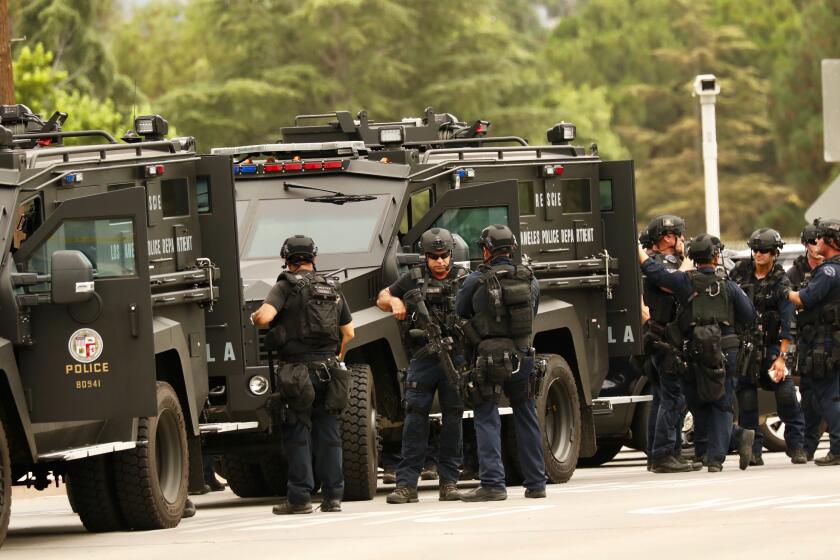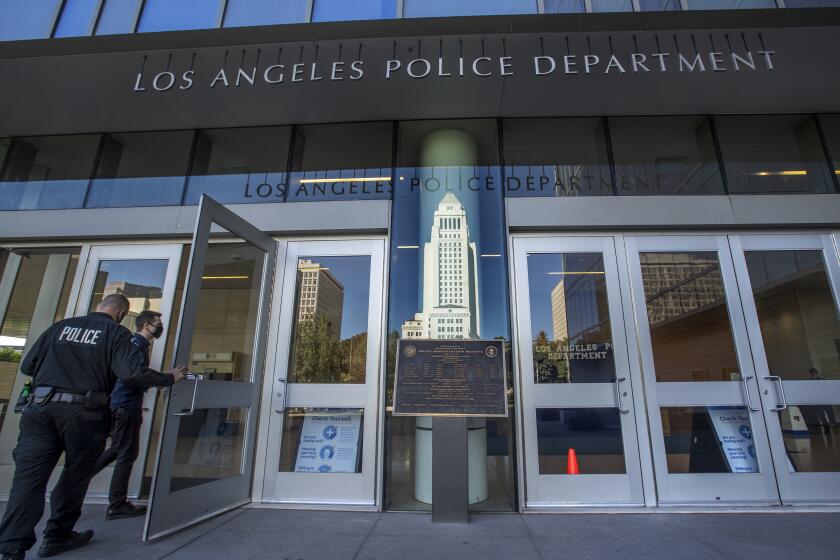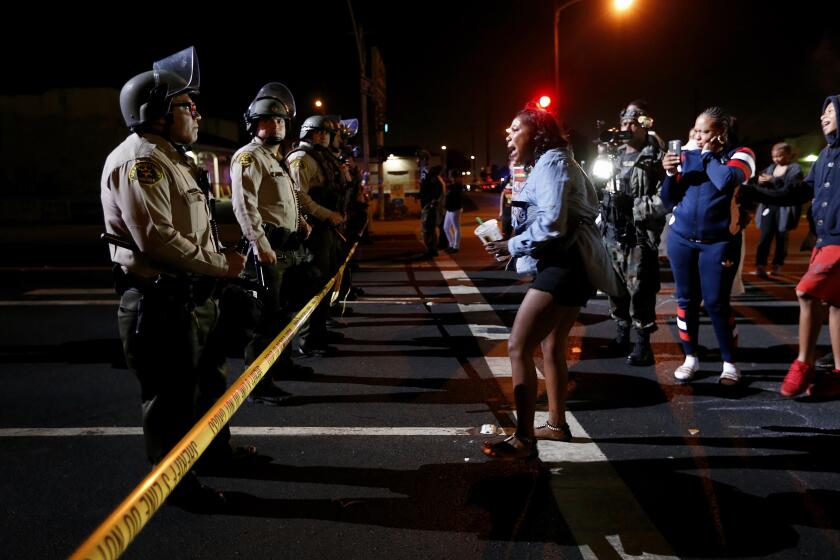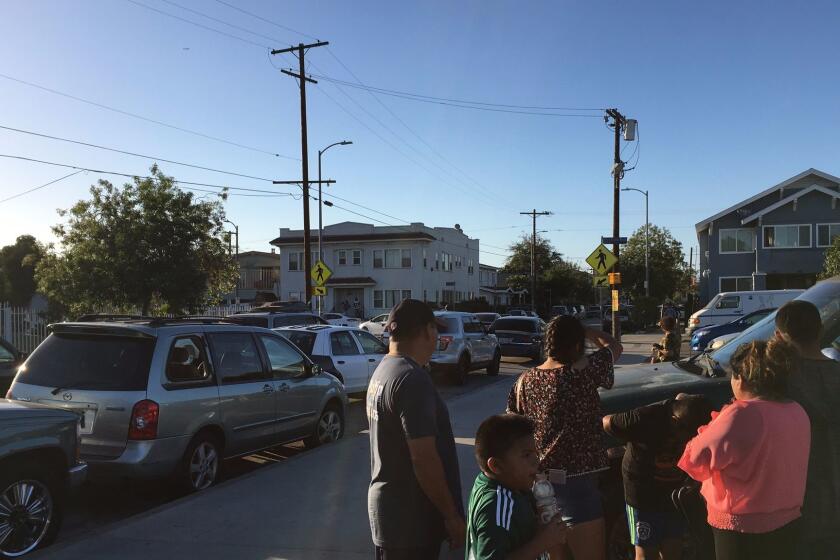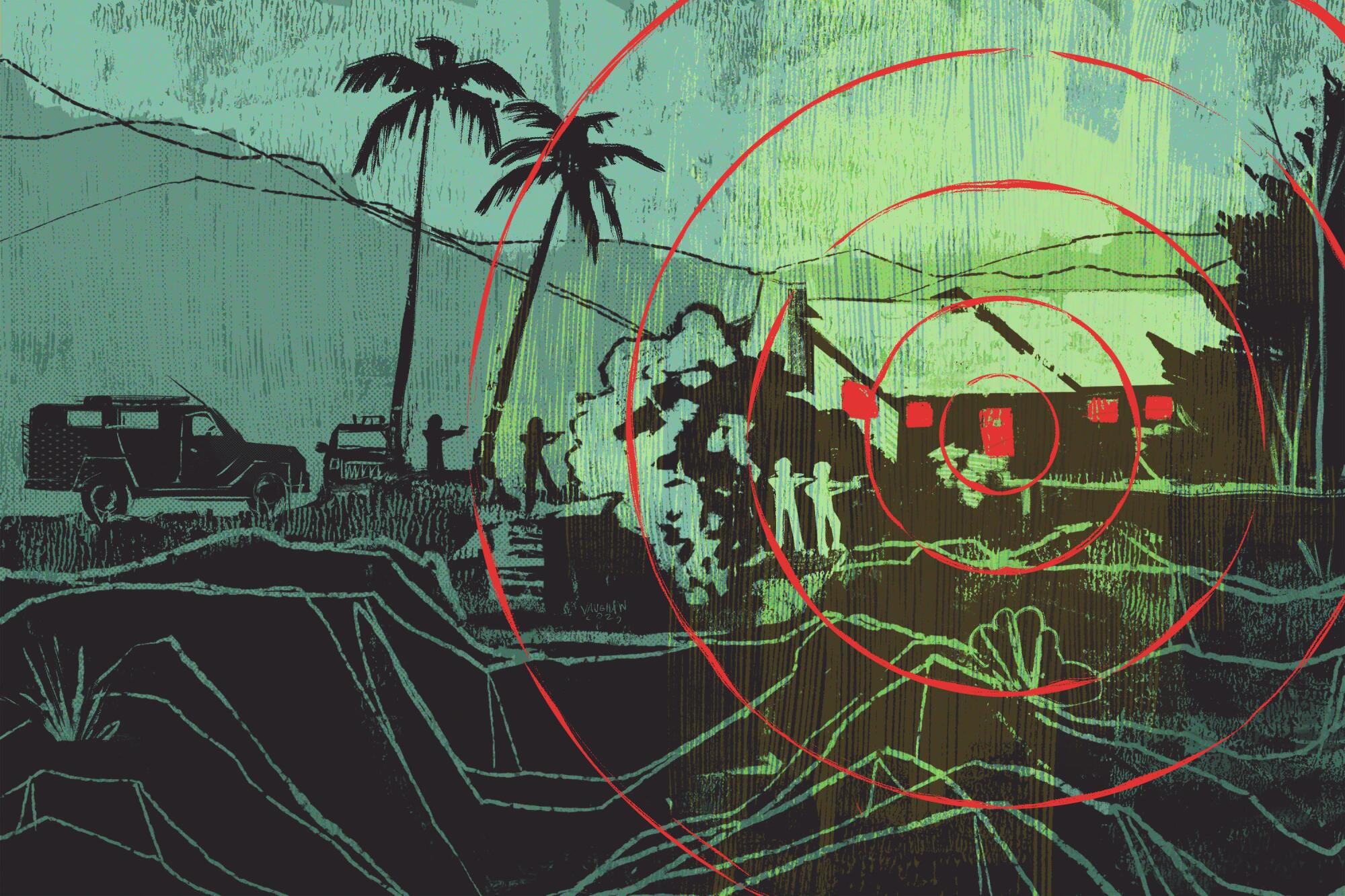
- Share via
Anthony Soderberg was wounded, no longer armed and positioned precariously on a steep embankment when Los Angeles Police Lt. Ruben Lopez radioed to the surrounding SWAT team that the mentally ill man they’d just flushed from a nearby home remained a threat and must not be allowed to leave.
SWAT Sgt. Tim Colomey, a crisis negotiator standing next to Lopez in the command center, was stunned — interpreting the remark, as he knew other officers would, as a kill order.
“What the f— did you just say?” Colomey asked Lopez, just before the barrage of gunfire erupted.
“It was like pop, pop, pop, pop, pop, pop, pop,” Colomey recalled. Officers outside “just started blasting away.”
In a frank and far-ranging legal deposition in March, the former SWAT sergeant offered extensive new details in support of allegations he first made in 2020 that the LAPD’s most elite tactical unit — a model for similar units across the country — is deeply corrupt and controlled by a violent inner circle known as the “SWAT Mafia.”
The 27-year LAPD veteran, who speaks quickly in a thick Boston accent, provided the deposition under oath as part of a lawsuit against the department and the city, in which he alleges he was transferred out of SWAT as retaliation for whistleblowing about the violence. He is seeking unspecified damages.
The city has denied Colomey’s claims in court; Lopez declined to comment on the allegations.
It is the SWAT team’s job to confront the most dangerous situations, and its members are specifically trained to end threats to the community. They are equipped and armed accordingly — and, department officials have said, rarely use force.
The Los Angeles Police Department as a whole has come under increasing scrutiny in recent years, including over its multibillion-dollar budget and its use of force. Colomey’s allegations and other recent scandals involving SWAT members have intensified the spotlight on the team.
In his deposition, Colomey explained at length why he views Soderberg’s death and two other incidents as examples of a “culture of violence” in the unit. He also alleged “SWAT Mafia” members controlled training and tactics, decided which younger officers got selected to join the team, showed up to incidents drunk and ensured lucrative overtime was given to them and their allies — for years making them some of the city’s highest paid employees.
Last year, LAPD Chief Michel Moore ordered an internal review of SWAT operations over the last decade after one officer was caught on video saying “happy hunting” to fellow officers before the team fatally shot a suspect downtown. The review rejected Colomey’s claims of a violent internal culture and found the team used deadly force in a small fraction of incidents.
Colomey has identified several lower-ranking officers as being members of the “SWAT Mafia,” and several unit supervisors and police commanders as being complicit in the group’s hold on power.
He described a period when he oversaw the SWAT training school — and “SWAT Mafia” members allegedly undermined him at every turn to assert their own power over the team — as “absolute hell.”
It was “the SWAT Mafia machine trying to run and control who they take into SWAT,” Colomey said, and “me trying to keep control of that machine.”
This story draws heavily on Colomey’s March deposition, a nearly 200-page partial transcript of which Colomey’s attorneys allowed The Times to review. Colomey and his legal team otherwise declined to comment. The city had tried to block The Times from seeing the transcript.
An LAPD sergeant alleging that a group of officers known as the ‘SWAT mafia’ corrupted the tactical unit had previously flagged the group’s influence.
It also draws on court filings in Colomey’s case and other lawsuits against the city; interviews with current and former SWAT team members; and police and prosecution records from several SWAT incidents in which Colomey alleges that excessive force was used.
The Times also sought comment from those Colomey accuses of wrongdoing, but they either declined to comment, did not respond or could not be reached. City Atty. Hydee Feldstein Soto’s office, which is representing the officers named in Colomey’s lawsuit, also declined to comment. A police union official said an attorney for the city had advised the officers to not speak to The Times.
Colomey left SWAT for another LAPD assignment at Los Angeles International Airport in 2019, and the SWAT team he describes in his lawsuit is not the same one that exists today. Some SWAT members whom Colomey accuses of misconduct no longer work in the unit or for the department at all, while others are headed for retirement, department sources said. Top brass also have revised SWAT policies based in part on problems Colomey flagged, to bring the vaunted unit in line.
Still, Colomey‘s deposition suggests that corruption in the unit is deeply rooted and far from rooted out — perpetuated through excessive force in the field as well as through insubordination, sabotage and cover-ups.
Controlling the unit
The “SWAT Mafia’s” power derived mainly from two things, according to Colomey: its influence over the team’s two lieutenants — Lopez and Lt. Lee McMillion — and its related ability to control which younger officers made it into the elite unit.
The “SWAT Mafia,” he said, is led by older officers with the rank of Police Officer III +1, or “+1s,” as well as other “senior operators” with tenure on the team. Although sergeants such as Colomey outrank +1s, he said the +1s in SWAT — who often doubled as its tactical experts — were protected and given vast leeway by the team’s two lieutenants.
Lopez, Colomey alleged, “bows down to that group of SWAT operators,” allowing them to get away with policy violations and protecting them from scrutiny from other department leaders.
McMillion was incredibly close with the “SWAT Mafia” members and constantly protected them, Colomey alleged in his deposition. McMillion did not respond to requests for comment.
Another former member of the SWAT team, who spoke on condition of anonymity, also said McMillion protected the “SWAT Mafia.”
An L.A. police SWAT member was recorded saying “happy hunting” to other officers before police shooting, LAPD Chief Michel Moore confirmed to The Times.
On calls in the city, McMillion would ignore sergeants and speak almost exclusively with the +1s on scene, Colomey alleged. He would also “badmouth” younger officers seeking to join SWAT and even defer to the +1s directly when considering appointments to the team, in violation of the LAPD’s standard process for promotions.
Worse, Colomey said, were the “SWAT Mafia’s” more covert attempts at sabotaging certain SWAT applicants in favor of others, which Colomey said occurred during SWAT schools he oversaw in both 2016 and 2018.
Officers looking to join SWAT must meet certain qualifications, have a relatively clean disciplinary record, and go through the school, where they must show additional physical and tactical proficiency — including in simulated scenarios.
The team’s most senior officers, including the +1s, often run those simulations. Part of their job is to evaluate the candidates, flag those who are under-performing or breaking rules and make suggestions as to who should be removed.
Colomey alleged that the +1s in the “SWAT Mafia” would intentionally give an applicant they didn’t like misdirection on what to do in simulations, then ding them for acting accordingly and flag them for removal.
They would also flat out lie about the performance of candidates, he alleged in the deposition.
In one example from 2018, Colomey said, two SWAT applicants — one favored by the “SWAT Mafia” and one disfavored — were running through a hostage simulation in a downtown building. The officers, armed with paintball guns, ended up shooting both the suspect and the hostage. Afterward, it was obvious from the paint markings on the wall that they had fired a huge — and inappropriate — number of rounds.
“The hostage and the suspect were all shot up,” Colomey said.
When Colomey asked what happened, he said in his deposition, Officer Rick Anzaldo — a current SWAT +1 whom Colomey accuses of being a “SWAT Mafia” leader — told him the officer the “SWAT Mafia” favored had fired only three rounds and the second officer had fired the rest.
Anzaldo could not be reached for comment.
Colomey said he wrote up paperwork to remove the disfavored officer from the school based on Anzaldo’s claims. But on his drive home, he said, he started having misgivings; he called the disfavored officer — whom he knew from an LAPD jogging group — and asked him what had happened.
The officer told him that he had fired only two rounds, while the officer favored by the “SWAT Mafia” “was just coming across spraying,” Colomey said.
The next day, Colomey accused Anzaldo of lying and demanded Lopez remove Anzaldo from the school, Colomey alleged in his deposition.
“I’m like ‘Ruben, this should be a 128,’” Colomey recalled saying to Lopez, referring to an official complaint that can lead to an internal investigation. “He’s interfering with another officer’s career.”
Colomey said Lopez told him he wouldn’t remove Anzaldo, who was the most senior +1 in SWAT. Instead, Colomey said, Anzaldo received a warning to correct his behavior.
Incidents in the field
At the request of Police Commission members, department officials presented data to the public Tuesday showing that SWAT officers used force in about 9% of incidents they responded to over the last decade — or 95 out of 1,031 incidents.
Capt. Mario Mota, who gave the presentation, said the team’s 70 or so officers are “highly professional and dedicated to what they do.”
Colomey’s deposition tells a far different story. Worse than the “SWAT Mafia’s” actions in training, he said, was its influence in the field.
Colomey pointed to three specific incidents in which he alleged the “SWAT Mafia’s” influence led to excessive force being used — and then covered up, ignored by higher-ups, or both.
The first occurred in May 2014, he said, when SWAT officers were called to bring a mentally ill homeless man named Carlos Ocana down from a billboard atop a downtown building.
After coaxing Ocana down the billboard’s ladder with a cigarette, Officer Stephen Scallon shot him with a Taser, causing him to fall off the building to his death — missing an airbag that firefighters had inflated below, according to LAPD records.
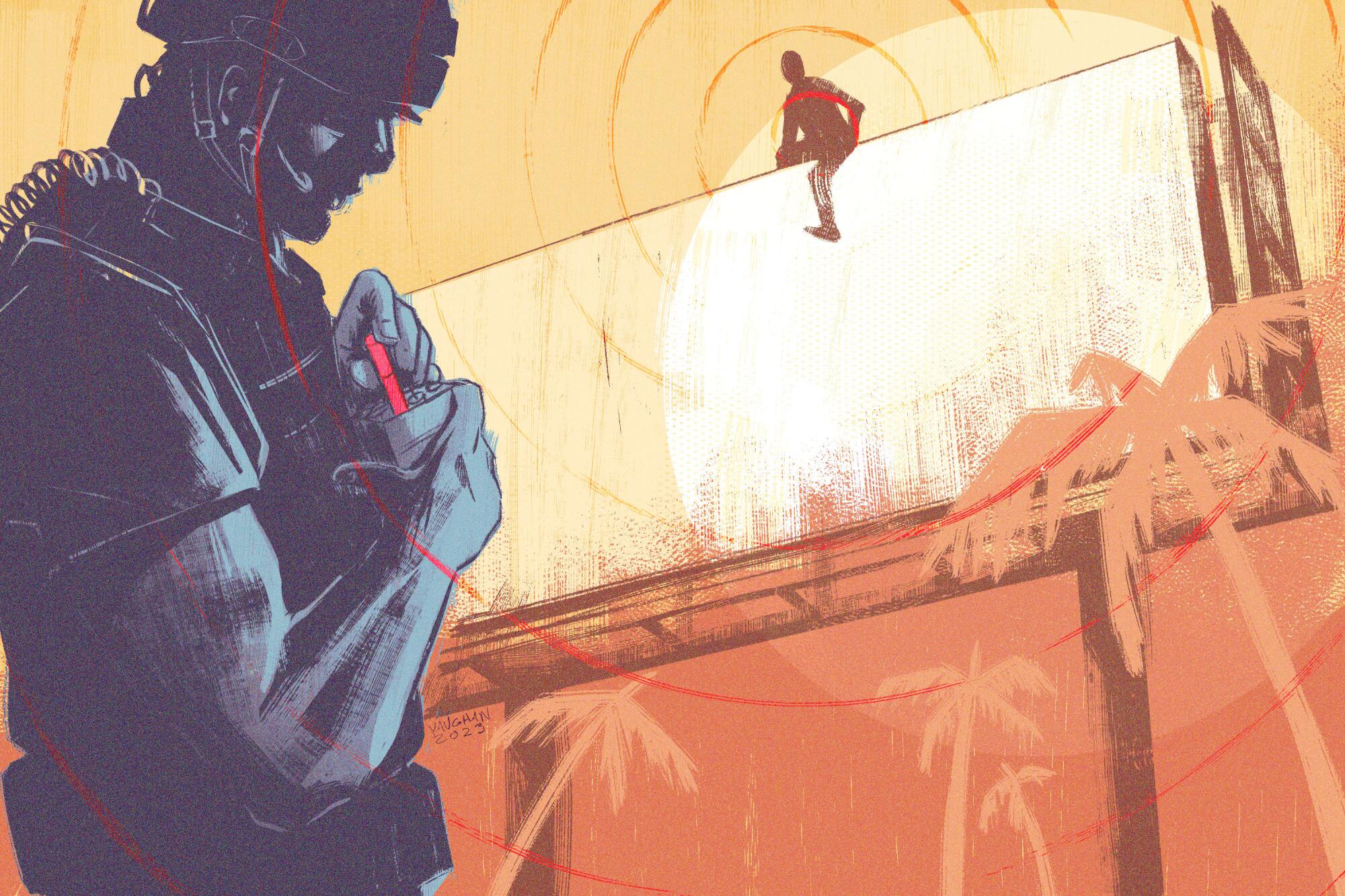
Scallon told investigators that he believed Ocana was “probably going to fight with the officers” and that stunning Ocana would cause him to “just fall onto the roof” — not off it.
An LAPD force review board found Scallon’s use of the Taser was reasonable, but then-Chief Charlie Beck overruled the board, finding that a reasonable officer with the advanced SWAT training that Scallon had “would not have discharged the Taser” under such circumstances, according to LAPD records.
Given Beck’s ruling, the department issued Scallon an official “reprimand” for breaking department policy, which limits the use of Tasers to those who represent a threat and discourages their use on people at risk of falling from elevated positions. Scallon maintained, including in unsuccessful court challenges to his punishment, that using the Taser on Ocana was part of the tactical plan that day.
Scallon, now a reserve officer, could not be reached for comment.
In his deposition, Colomey identified Scallon as a member of the “SWAT Mafia,” and said his decision to stun Ocana had “outraged” other SWAT members because Ocana “was not threatening the officers in any way.”
Colomey alleged that during a meeting, Sgt. Mark Jackson — the supervisor on the day of Ocana’s death — had blasted Scallon and Officer David Keortge, who was with Scallon on the roof, for lying about the incident by suggesting that deploying a Taser on Ocana was part of the tactical plan.
“Mark was like, there was never a plan. Steve acted on his own, rogue, and just Tased this man off the roof,” Colomey said in his deposition.
Keortge is no longer with the LAPD. Neither he nor Jackson could be reached for comment.
Colomey said Scallon was transferred to the LAPD’s underwater dive unit, “a coveted position such as SWAT that comes with bonus pay.”
Pete White, executive director of the Los Angeles Community Action Network, said community members in skid row had told officers that day that Ocana was known to climb buildings and trees when he got nervous. The officers could have de-escalated the situation by waiting for a “SMART team” behavioral health clinician, but instead chose force and Tasered Ocana off the roof for no reason, White said.
“We didn’t get SMART, we got SWAT, whose actions led to the loss of his life,” White said. “You can probably guess our outrage.”
The second incident Colomey raised was the May 2017 killing of Soderberg.
Soderberg had broken into a home in Sunland, then exchanged gunfire with officers before being shot and wounded. After officers shot tear gas into the home, Soderberg was spotted lying in a ball with his hands at his face at the side of the home. Officers then deployed “stinger grenades” that forced him farther from the home and into the ravine, Colomey said.
It was then that Lopez allegedly told the surrounding SWAT officers to not let Soderberg leave, and a number of officers — including three led by Anzaldo — opened fire once more, Colomey said in the deposition.
Even as Soderberg was skidding down the ravine face down and “clearly dead,” Anzaldo radioed that he was still moving and ordered his officers to keep firing, Colomey said.
“And then his three once again all fire into this guy’s back.”
After the incident, the Los Angeles Police Commission found a dozen officers had violated rules governing the use of deadly force, and Soderberg’s mother received a $1.15-million settlement from the city.
During roughly the past 5½ years, the city has paid out more than $245 million to resolve legal claims involving the LAPD.
Prosecutors in the Los Angeles County district attorney’s office who reviewed the case concluded that there was “insufficient evidence to prove beyond a reasonable doubt” that Anzaldo’s three officers had acted criminally when they opened fire at the end of the encounter.
They quoted Anzaldo as saying just after the shooting that Soderberg had “started to move” and that the three officers had “put him down.”
Colomey said the incident was even more out of control than those who had reviewed the case knew.
Three officers were struck by friendly fire during the incident, Colomey alleged, though only one reported being struck, by a ricochet bullet in the leg. Anzaldo was struck in his gas mask and another officer was struck in his tactical belt, but neither reported it to investigators, Colomey said in the deposition.
Colomey said higher-ranking officers knew about the bullet strikes, but also failed to report them.
When Soderberg’s family sued the city over his death, officials didn’t initially disclose Colomey’s internal complaint about the incident, according to their attorney, Greg Kirakosian. After Colomey filed his lawsuit, making his claims public, Kirakosian asked to depose him and the city promptly decided to settle the case out of court.
Kirakosian said Soderberg’s death was a prime example of the SWAT team’s “egregious” reliance on force.
“From every which angle and distance you could imagine, [Soderberg] was fired upon while he was choking on gas,” Kirakosian said.
The third incident Colomey flagged occurred the month after Soderberg was killed, in June 2017, when SWAT officers surrounded a suspect named Jose Rauda as he holed up in a backyard shed after exchanging gunfire with officers during a chase.
At some point during the encounter, Colomey said, Sgt. Mike Porter had Officer Rene Gonzalez move up toward the shed to pull down a shade that was obstructing the sightline from the team’s armored vehicle parked nearby. Gonzalez was shot in the helmet.
Police said Rauda fired the shot; Colomey said there was some dispute as to where the round came from, and whether it could have been fired by another officer behind Gonzalez. Either way, Gonzalez was able to retreat and the standoff continued, with multiple lulls between subsequent gunfire.
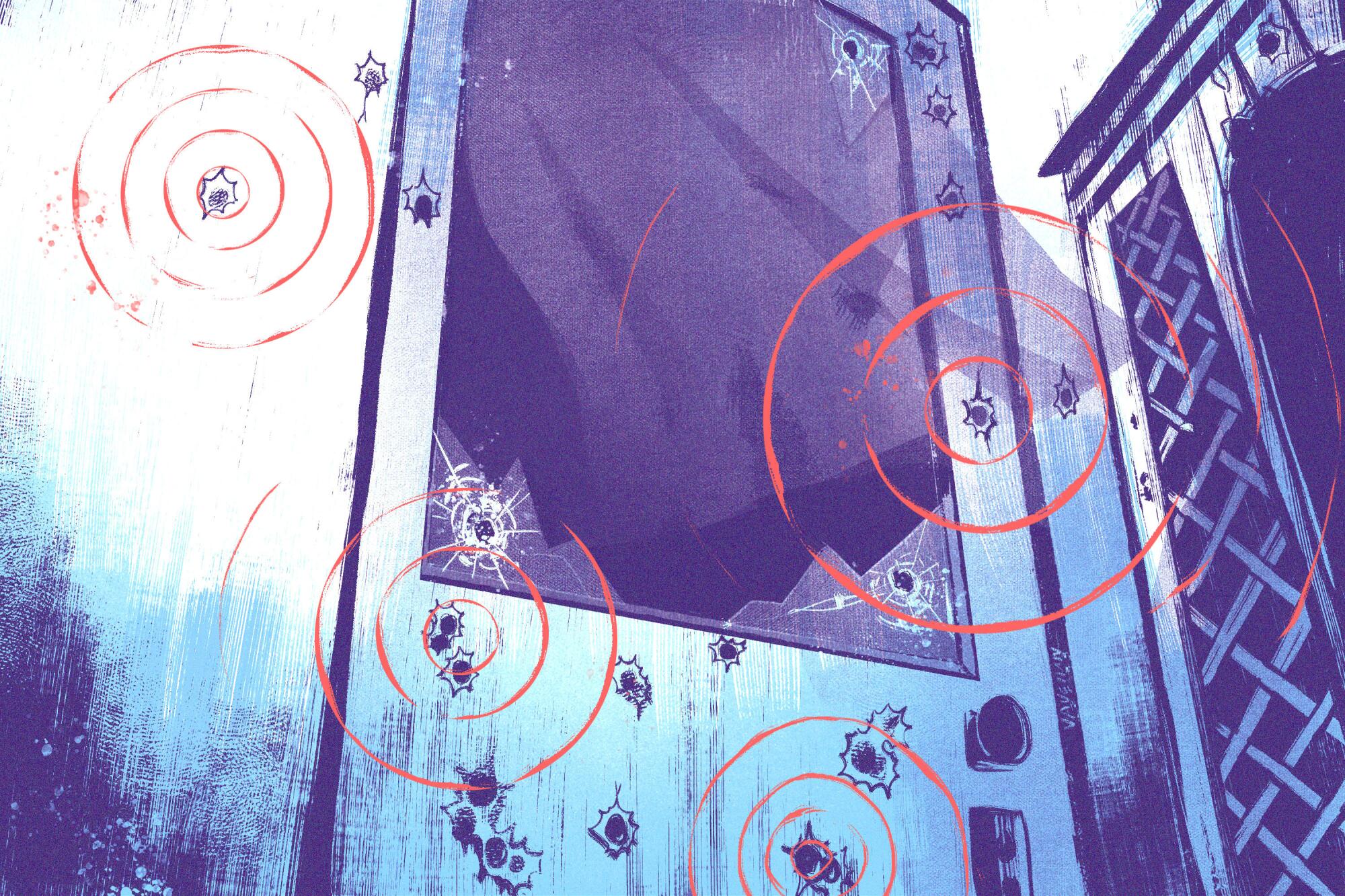
Colomey said in his deposition that Porter should have immediately removed Gonzalez from the scene, because officers who are wounded “get emotionally involved.” Instead, Gonzalez, who had a concussion, was allowed to remain on scene, where he went on to fire a barrage of bullets at Rauda, probably causing additional “contagious” gunfire among the other officers on scene, Colomey alleged.
While seven other officers fired two or three rounds apiece, Gonzalez fired an entire “30-round magazine clip of his assault rifle and then [used] his second clip,” Colomey alleged in the deposition.
Miraculously, Rauda was not hit. He was later struck by a beanbag round and taken into custody. He has since been sentenced to life in prison for attempted murder of police officers, and could not be reached for comment.
Gonzalez and Porter also could not be reached for comment.
A gunman accused of firing at Los Angeles police and wounding a search dog during a gun battle has been charged with 19 counts of attempted murder on officers as well as other charges, prosecutors said Wednesday.
Colomey said there were zero “command-and-control” protocols applied during the response, none of the department’s guidance for avoiding “contagious” fire was followed, and Porter and the other involved officers should have been heavily disciplined.
Instead, he said, the entire squad was awarded the Medal of Valor.
“The involved officers are commended for their unflinching courage, commitment to duty, and superior tactics in the face of an armed assault,” the department said in a video it posted to YouTube after the incident. “Their valiant actions in defense of life, and the community at large, reflect the highest traditions of law enforcement and of the Los Angeles Police Department.”
Deciding to speak out
Colomey served in SWAT for 11 years, many of them alongside his brother. Earlier in his career, he survived getting hit by a car while on duty and endured 13 surgeries to get back to the force. He has long considered being a police officer — serving Los Angeles residents — a calling, he said in an internal LAPD podcast years ago.
In his deposition, he said he had tried for years to confront the “SWAT Mafia” and the violent culture it was perpetuating from within.
Colomey said he repeatedly complained to Lopez and McMillion, to captains above them and to other LAPD leaders, to no avail. He also shared his concerns with internal affairs starting in 2018, he said, when an internal affairs investigation was launched into an anonymous complaint alleging Colomey and Lopez had shown preferential treatment and submitted false paperwork during SWAT schools.
Colomey said an internal affairs officer told him that “the chief” — presumably Moore, who had just been appointed to lead the department — “wanted to find out the inner workings of SWAT.”
So, he said, he told him about the “SWAT Mafia” and how they controlled who was selected into SWAT; about the specific incidents in which he felt the team had gotten away with using excessive force; and about his belief that the alleged corruption was sanctioned by higher ranking officers.
He said he also told the internal affairs officer that he fully expected the “SWAT Mafia” to retaliate against him for exposing them.
“I said, ‘I know what SWAT is. It’s [a] train moving and I just stood in front of it.’ ”
Colomey alleges he was subsequently retaliated against as predicted. He said he was bullied and forced out of the SWAT team and transferred to a position at LAX — which he referred to in his lawsuit as an example of a specific form of internal LAPD retribution known as “freeway therapy.”
Looking ahead
How Colomey’s case will play out is unknown.
The city could seek a settlement to avoid the additional scrutiny of a trial, or keep fighting. If the case does go to trial, it could further divide the department’s most elite tactical team — with some members testifying in support of Colomey’s claims and others disputing them.
Though the department has rejected Colomey’s allegations of a violent SWAT culture as unfounded, others in the unit have said they hold some truth.
One former SWAT team member, who requested anonymity to speak candidly about internal dynamics within the department, said “the SWAT Mafia is very much a real thing.”
The person said the belief among many older members of the unit is that SWAT comes before everything else, loyalty is paramount and problems within the unit should never be revealed to outsiders.
The person also agreed with Colomey that McMillion protected the “SWAT Mafia.”
A former LAPD commander with knowledge of the situation, who also spoke on condition of anonymity to discuss internal personnel issues candidly, said much of what Colomey has alleged is true — including that the unit’s +1s had excess power and essentially ran the unit.
However, once Colomey started complaining to higher-ups, changes were made on a dramatic scale, including to the SWAT manual, the former commander said. And he questioned Colomey’s claims of being forced from SWAT, saying top brass had asked Colomey to remain in the unit.
In his deposition, Colomey said far too little has been done over the years to reform the SWAT team, in part because commanders don’t really want to know how bad things have gotten.
“The command staff on this department all the way up to Chief Moore know that if they looked — if they had to make a change in SWAT — the brutal facts that would come out would be too overwhelming,” he said.
“I had chiefs directly say that to me, that they know things are wrong,” he said. “And I’ve seen them start the process of trying to make change and then seen them stop and literally disappear and change their tune, including Chief Moore.”
An LAPD spokeswoman said the department cannot comment on matters of pending litigation. Moore did not respond to a request for comment.
More to Read
Sign up for Essential California
The most important California stories and recommendations in your inbox every morning.
You may occasionally receive promotional content from the Los Angeles Times.
